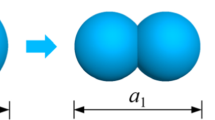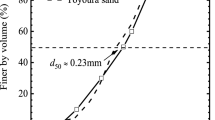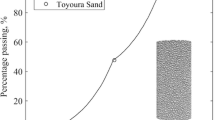Abstract
Diffuse instability is a typical failure mode of sand that occurs before the perfect plastic flow condition is attained. Whereas extensive laboratory experiments have demonstrated the macro-scale responses associated with such a failure mode, its underlying microscopic mechanism remains unclear. Therefore, no effective predictions can be made incorporating sophisticated constitutive models of sand, particularly when various drainage conditions are considered. In the present study, diffuse instability is first investigated using the discrete element method (DEM). Herein, partially drained and fully drained conditions are imposed to investigate the instability failure in proportional strain loading and constant shear drained tests, respectively. Then, both macro- and micro-scale second-order work criteria are applied to identify the occurrence of instability. Furthermore, the main features associated with the onset of diffuse instability are presented. The diffuse instability behavior of sand is observed to be closely related to its fabric evolution. Eventually, independent criteria for diffuse instability under various drainage conditions are determined considering the DEM results. In addition, a newly developed anisotropic constitutive model with a fabric evolution law is applied to simulate the mechanical behavior of sand and the instability that ensues. The model exhibits satisfactory agreement with the DEM simulation results. Overall, this study is aimed at elucidating why diffuse instability occurs prior to the plastic limit and how to predict it under various drainage conditions.












Similar content being viewed by others
References
Alipour MJ, Lashkari A (2018) Sand instability under constant shear drained stress path. Int J Solids Struct 150:66–82
Been K, Jefferies MG (1985) A state parameter for sands. Géotechnique 35(2):99–112
Borja RI (2006) Condition for liquefaction instability in fluid-saturated granular soils. Acta Geotech 1(4):211–224
Buscarnera G, Nova R (2011) Modelling instabilities in triaxial testing on unsaturated soil specimens. Int J Numer Anal Methods Geomech 35(2):179–200
Chu J, Lo SCR, Lee IK (1993) Instability of granular soils under strain path testing. J Geotech Eng 119(5):874–892
Chu J, Leroueil S, Leong WK (2003) Unstable behaviour of sand and its implication for slope instability. Can Geotech J 40(5):873–885
Chu J, Leong WK, Loke WL, Wanatowski D (2012) Instability of loose sand under drained conditions. J Geotech Geoenviron Eng 138(2):207–216
Cundall PA, Strack ODL (1979) A discrete numerical mode for granular assemblies. Géotechnique 29(1):47–65
Chambon R, Caillerie D (1999) Existence and uniqueness theorems for boundary value problems involving incrementally nonlinear models. Int J Solids Struct 36(33):5089–5099
Darve F (1996) Liquefaction phenomenon of granular materials and constitutive stability. Eng Comput 13(7):5–28
Darve F, Servant G, Laouafa F, Khoa HDV (2004) Failure in geo-materials: continuous and discrete analyses. Comput Method Appl M 193(27):3057–3085
Dong QY, Xu CJ, Cai YQ, Juang H, Wang J, Yang ZX, Gu C (2016) Drained instability in loose granular material. Int J Geomech 16(2):04015043
Daouadji A, Darve F, Gali HA, Hicher PY, Laouafa F, Lignon S, Nicot F, Nova R, Pinheiro M, Prunier F, Sibille L, Wan R (2011) Diffuse failure in geomaterials: experiments, theory and modelling. Int J Numer Anal Methods Geomech 35(16):1731–1773
Eckersley D (1991) Instrumented laboratory flow slides. Géotechnique 41(2):277–279
Hadda N, Nicot F, Bourrier F, Sibille L, Radjai F, Darve F (2013) Micromechanical analysis of second-order work in granular media. Granul Matter 15(2):221–235
Hill R (1958) A general theory of uniqueness and stability in elastic-plastic solids. J Mech Phys Solids 6(3):236–249
Imposimato S, Nova R (1998) An investigation on the uniqueness of the incremental response of elastoplastic models for virgin sand. Mech Cohesive-Frict Mater 3(1):65–87
Lade PV, Pradel D (1990) Instability and plastic flow of soils. I: Experimental observations. J Eng Mech-ASCE 116(11):2532–2550
Lade PV, Liggio CD (2014) Stability and instability of granular materials under imposed volume changes: experiments and predictions. Int J Geomech 14(5):04014020
Lade PV, Yamamuro JA (2011) Evaluation of static liquefaction potential of silty sand slopes. Can Geotech J 48:247–264
Lancelot L, Shahrour I, Mahmoud MA (2004) Instability and static liquefaction on proportional strain paths for sand at low stresses. J Eng Mech-ASCE 130(11):1365–1372
Lashkari A, Yaghtin MS (2018) Sand flow liquefaction instability under shear-volume coupled strain paths. Géotechnique 68(11):1002–1024
Lashkari A, Khodadadi M, Binesh SM, Rahman MM (2019) Instability of particulate assemblies under constant shear drained stress path: DEM approach. Int J Geomech 19(6):04019049
Li XS, Dafalias YF (2002) Constitutive modeling of inherently anisotropic sand behavior. J Geotech Geoenviron Eng 128(10):868–880
Li XS, Dafalias YF (2012) Anisotropic critical state theory: role of fabric. J Eng Mech-ASCE 138(3):263–275
Li XS, Wang Y (1998) Linear representation of steady-state line for sand. J Geotech Geoenviron Eng 124(12):1215–1217
Lü XL, Qian JG, Huang MS (2017) Instability of sands under axisymmetric proportional strain and stress loadings. Eur J Environ Civ Eng 23:1–17
Jiang MD, Yang ZX, Barreto D, **e YH (2018) The influence of particle-size distribution on critical state behavior of spherical and non-spherical particle assemblies. Granul Matter 20:80
Jrad M, Sukumaran B, Daouadji A (2012) Experimental analyses of the behaviour of saturated granular materials during axisymmetric proportional strain paths. Eur J Environ Civ Eng 16(1):111–120
Monkul MM, Yamamuro JA, Lade PV (2011) Failure, instability, and the second work increment in loose silty sand. Can Geotech J 48(6):943–955
Mital U, Andrade JE (2016) Mechanics of origin of flow liquefaction instability under proportional strain triaxial compression. Acta Geotech 11(5):1015–1025
Nakata Y, Hyodo M, Murata H, Yasufuku N (1998) Flow deformation of sands subjected to principal stress rotation. Soils Found 38(2):115–128
Nicot F, Darve F (2011) Diffuse and localized failure modes: two competing mechanisms. Int J Numer Anal Methods Geomech 35(5):586–601
Nicot F, Laouafa F, Darve F (2011) Second-order work, kinetic energy and diffuse failure in granular materials. Granul Matter 13(1):19–28
Nicot F, Hadda N, Bourrier F, Sibille L, Wan R, Darve F (2012) Inertia effects as a possible missing link between micro and macro second-order work in granular media. Int J Solids Struct 49(10):1252–1258
Ning Z, Evans MT, Andrade J (2013) Particulate study of drained diffuse instability in granular material. In: Proceedings of ASCE geo-congress 2013: stability and performance of slopes and embankments III, pp 1290–1299
Nova R (1994) Controllability of the incremental response of soil specimens subjected to arbitrary loading programs. J Mech Behav Mater 5(2):193–202
Nouguierlehon C, Cambou B, Vincens E (2010) Influence of particle shape and angularity on the behaviour of granular materials: a numerical analysis. Int J Numer Anal Methods Geomech 27(14):1207–1226
Osinov VA, Wu W (2009) Wave speeds, shear bands and the second-order work for incrementally nonlinear constitutive models. Acta Mech 202(1–4):145–151
Perez JCL, Kwok CY, Osullivan C, Huang X, Hanley KJ (2016) Exploring the micro-mechanics of triaxial instability in granular materials. Géotechnique 66(9):1–16
PFC3D 5.0 (2014) Users’ manual. Itasca Consulting Group, Minneapolis
Ramos AM, Lizcano A, Andrade JE (2012) Modelling diffuse instabilities in sands under drained conditions. Géotechnique 62(6):471–478
Rothenburg L, Selvadurai APS (1981) A micromechanical definition of the Cauchy stress tensor for particular media. In: Selvadurai A (ed) Mechanics of structured media. Elsevier, Amsterdam, pp 469–486
Rudnicki JW, Rice JR (1975) Conditions for the localization of deformation in pressure-sensitive dilatant materials. J Mech Phys Solids 23(6):371–394
Sawicki A, Świdziński W (2010) Modelling the pre-failure instabilities of sand. Comput Geotech 37(6):781–788
Sibille L, Nicot F, Donzé FV, Darve F (2007) Material instability in granular assemblies from fundamentally different models. Int J Numer Anal Methods Geomech 31(3):457–481
Sivathayalan S, Logeswaran P (2007) Behaviour of sands under generalized drainage boundary conditions. Can Geotech J 44(2):138–150
Sivathayalan S, Logeswaran P (2008) Experimental assessment of the response of sands under shear-volume coupled deformation. Can Geotech J 45(9):1310–1323
Skopek P, Morgenstern NR, Robertson PK, Sego DC (1994) Collapse of dry sand. Can Geotech J 31(6):1008–1014
Vardoulakis I, Sulem J (1995) Bifurcation analysis in geomechanics. Chapman and Hall Publications, London
Wanatowski D, Chu J (2007) Static liquefaction of sand in plane strain. Can Geotech J 44(3):299–313
Weingartner B, Osinov VA, Wu W (2006) Acceleration wave speeds in a hypoplastic constitutive model. Int J Nonlinear Mech 41(8):991–999
Wan R, Nicot F, Darve F (2017) Failure in geomaterials: a contemporary treatise, 1st edn. ISTP Press—Elsevier, London
Yoshimine M, Ishihara K (1998) Flow potential of sand during liquefaction. J Jpn Geotechn Soc 38(3):189–198
Yoshimine M, Ishihara K, Vargas W (1998) Effects of principal stress direction and intermediate principal stress on undrained shear behavior of sand. Soils Founds 38(3):179–188
Yang ZX, Wu Y (2017) Critical state for anisotropic granular materials: a discrete element perspective. Int J Geomech 17(2):04016054
Yang ZX, Xu TT, Chen YN (2018) Unified modeling of the influence of consolidation conditions on monotonic soil response considering fabric evolution. J Eng Mech-ASCE 144(8):04018073
Yang ZX, Yang J, Wang LZ (2013) Micro-scale modeling of anisotropy effects on undrained behavior of granular soils. Granul Matter 15(5):557–572
Acknowledgements
The research described was funded by the National Key R & D program of China (No. 2016YFC0800200) and the Natural Science Foundation of China (Grant Nos. 51825803, 51578499, 51761130078).
Author information
Authors and Affiliations
Corresponding author
Additional information
Publisher's Note
Springer Nature remains neutral with regard to jurisdictional claims in published maps and institutional affiliations.
Rights and permissions
About this article
Cite this article
Wu, Q.X., Xu, T.T. & Yang, Z.X. Diffuse instability of granular material under various drainage conditions: discrete element simulation and constitutive modeling. Acta Geotech. 15, 1763–1778 (2020). https://doi.org/10.1007/s11440-019-00885-9
Received:
Accepted:
Published:
Issue Date:
DOI: https://doi.org/10.1007/s11440-019-00885-9




